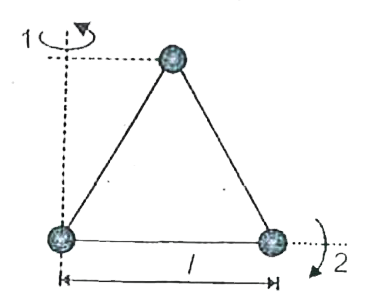Three paricles, each of mass m and carrying a charge q each, are suspended from a common pointby insulating massless strings each of length L. If the particles are in equilibrium and are located at the corners of an equilateral triangle of side a, calculate the charge q on each particle. Assume .
To solve the problem, we will follow these steps:
Step 1: Understand the Setup
We have three particles, each with mass m and charge q, suspended from a common point by massless strings of length L. The particles are positioned at the corners of an equilateral triangle with side length a. We need to find the charge q on each particle when they are in equilibrium.
Step 2: Analyze the Forces
Each particle experiences three forces:
1. The gravitational force mg acting downward.
2. The tension T in the string acting along the string.
3. The electrostatic force F due to the other two charges.
Step 3: Calculate the Electrostatic Force
The electrostatic force F between any two charges q separated by a distance a is given by Coulomb's law:
F=kq2a2
where k is Coulomb's constant.
Step 4: Determine the Resultant Electrostatic Force
In an equilateral triangle, the resultant force F′ on one charge due to the other two charges can be calculated using vector addition. Since the angle between the forces is 60∘:
F′=√F2+F2+2F⋅F⋅cos(60∘)=√F2+F2+F2=√3F2=√3F
Substituting F:
F′=√3(kq2a2)=√3kq2a2
Step 5: Set Up the Equilibrium Conditions
In equilibrium, the vertical component of the tension must balance the weight of the particle:
Tcosθ=mg
And the horizontal component of the tension must balance the resultant electrostatic force:
Tsinθ=F′
Step 6: Relate Tension and Angles
From the triangle formed by the strings and the vertical line, we have:
tanθ=F′mg
Substituting F′:
tanθ=√3kq2/a2mg
Step 7: Find the Lengths in Terms of L and a
The distance from the centroid to a vertex in an equilateral triangle is given by:
OB=a√3
Using the geometry of the situation, we can relate tanθ to L:
tanθ=OBL=a/√3L
Step 8: Combine the Equations
Equating the two expressions for tanθ:
a/√3L=√3kq2mga2
Cross-multiplying gives:
a⋅mga2=√3kq2L
Simplifying:
mga3=√3kq2L
Step 9: Solve for q
Rearranging gives:
q2=mga3√3kL
Taking the square root:
q=√mga3√3kL
Step 10: Substitute for k
Using k=14πϵ0:
q=
⎷mga3√3⋅14πϵ0⋅L=√4πϵ0mga3√3L
Final Result
Thus, the charge q on each particle is:
q=√4πϵ0mga3√3L
We have three particles, each with mass m and charge q, suspended from a common point by massless strings of length L. The particles are positioned at the corners of an equilateral triangle with side length a. We need to find the charge q on each particle when they are in equilibrium.
Each particle experiences three forces:
1. The gravitational force mg acting downward.
2. The tension T in the string acting along the string.
3. The electrostatic force F due to the other two charges.
The electrostatic force F between any two charges q separated by a distance a is given by Coulomb's law:
F=kq2a2
where k is Coulomb's constant.
In an equilateral triangle, the resultant force F′ on one charge due to the other two charges can be calculated using vector addition. Since the angle between the forces is 60∘:
F′=√F2+F2+2F⋅F⋅cos(60∘)=√F2+F2+F2=√3F2=√3F
Substituting F:
F′=√3(kq2a2)=√3kq2a2
In equilibrium, the vertical component of the tension must balance the weight of the particle:
Tcosθ=mg
And the horizontal component of the tension must balance the resultant electrostatic force:
Tsinθ=F′
From the triangle formed by the strings and the vertical line, we have:
tanθ=F′mg
Substituting F′:
tanθ=√3kq2/a2mg
The distance from the centroid to a vertex in an equilateral triangle is given by:
OB=a√3
Using the geometry of the situation, we can relate tanθ to L:
tanθ=OBL=a/√3L
Equating the two expressions for tanθ:
a/√3L=√3kq2mga2
Cross-multiplying gives:
a⋅mga2=√3kq2L
Simplifying:
mga3=√3kq2L
Rearranging gives:
q2=mga3√3kL
Taking the square root:
q=√mga3√3kL
Using k=14πϵ0:
q=
⎷mga3√3⋅14πϵ0⋅L=√4πϵ0mga3√3L
Thus, the charge q on each particle is:
q=√4πϵ0mga3√3L
Topper's Solved these Questions
- BOOK - CENGAGE PHYSICS ENGLISHCHAPTER - COULOMB LAW AND ELECTRIC FIELDEXERCISE - Solved examples10videos
COULOMB LAW AND ELECTRIC FIELD
- BOOK - CENGAGE PHYSICS ENGLISHCHAPTER - COULOMB LAW AND ELECTRIC FIELDEXERCISE - Exercises58videos
COULOMB LAW AND ELECTRIC FIELD
- BOOK - CENGAGE PHYSICS ENGLISHCHAPTER - CENGAGE PHYSICS DPPEXERCISE - subjective type51videos
CENGAGE PHYSICS DPP
- BOOK - CENGAGE PHYSICS ENGLISHCHAPTER - ELECTRIC CURRENT & CIRCUITSEXERCISE - Kirchhoff s law and simple circuits15videos
ELECTRIC CURRENT & CIRCUITS
Similar Questions
Knowledge Check
- Question 1 - Select One
Consider the charges q,q and -q placed at the vertices of an equilateral triangle of each side l. What is the force on each charge ?
Aq24√2πε0l2B−q24πε0l2Cq24πε0l2Dzero - Question 2 - Select One
Electric charges q,q,–2q are placed at the corners of an equilateral triangle ABC of side l. The magnitude of electric dipole moment of the system is
AqlB√3qlCzeroD4ql
Three particles each of mass m are kept at vertices of an equilateral triangle of side L. The gravitational field at centre due to these particle is
View SolutionThe gravitational potential energy of an isolated system of three particles, each of mass m, at the three corners of an equilateral triangle of side l is
View SolutionElectric charges q,q,–2q are placed at the corners of an equilateral triangle ABC of side l. The magnitude of electric dipole moment of the system is
View SolutionThree equal charge q0 each are placed at three corners of an equilateral triangle of side 'a'. Find out force acting on one of the charge due to other two charges ?
View SolutionTwo small spheres, each having a mass of 20 g, are suspended form a common point by two insulating strings of length 40 cm each. The spheres are identically charged and the speration between the balls at equilibrium is found to be 4 cm . Find the charge on each sphere.
View SolutionTwo identical pith balls, each carrying charge q, are suspended from a common point by two strings of equal length l. Find the mass of each ball if the angle between the strings is 2θ in equilibrium.
View Solution


